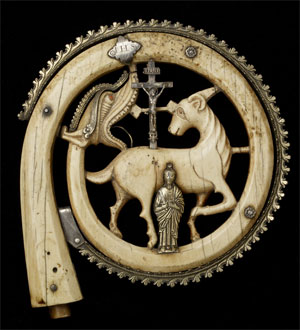
This ivory and metal crosier head from a pastoral staff was presented to the Museum in 1683 by Lady Dorothy Long (c.1620-1710). In the centre is the Paschal Lamb, symbolizing the salvation promised to the faithful, surrounded by a serpent with open mouth alluding to the jaws of Hell waiting for the sinners. Once thought to have belonged to the fourth century Saint Augustine of Hippo the crosier head is believed to date to the twelfth or thirteenth century.
The bronze mounts are later additions and include symbols of the Passion. The quatrefoil mount at the top above the serpent’s head, is decorated with ‘IHS’, the H surmounted by a cross and three Holy nails below, this was an emblem adopted by the Jesuits in the 1540s. The crucifix includes the titulus INRI, the Latin acronym for ‘Jesus of Nazareth, King of the Jews’ which according to the New Testament was affixed to the Holy Cross. The silver figure of Saint Paul at the base seems to be original.
This beautiful object goes almost all the way back to the foundation of the Museum. The entry for the crosier in the Book of Benefactors reads thus:
'The most noble of ladies, Dorothy, wife of that most generous and learned of men, Sir James Long, Bart, of Draycot Cerne in the county of Wiltshire , was the pride and joy of her family and her sex, and showed a deep interest in primitive religions and antiquities. Her piety and great good will to this University led her to give a carved ivory crosier which had belonged to Saint Augustine, Bishop of Hippo, to this museum to be placed with the other treasures.'
The crosier head is on display in the 'England 400-1600' gallery on the second floor.
Click to enlarge

Ivory and metal crosier head, measuring 15cm in diameter (AN1685A.600)
Further Information
Hook, M. and MacGregor, A., Medieval England: Archaeological Collections in the Ashmolean Museum from Alfred the Great to Richard III (Oxford: Ashmolean Museum, 1997).
Find out more about:
- British Medieval Collections at the Ashmolean Museum
- Book of Benefactors
- British Collections Online - searchable database of the collection
Eleanor Standley
January 2012